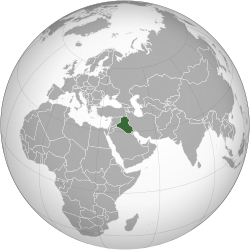| Name | Industry | Sector | Headquarters | Founded | Notes | Status |
|---|
| | |
|---|
| Agricultural Cooperative Bank of Iraq | Financials | Banks | Baghdad | 1935 | Oldest bank in Iraq | S | A |
| Al-Naser Airlines | Civil aviation | Airlines | Karrada | 2005 | Defunct 2019 | P | D |
| Asiacell | Telecommunications | Mobile telecommunications | Sulaymaniyah | 1999 | | P | A |
| Azmar Airlines | Civil aviation | Airlines | Sulaymaniyah | 2005 | Defunct 2015 | P | D |
| Babylon Bank | Financials | Banks | Baghdad | 1998 | | P | A |
| Baghdad Soft Drinks Co (BSDC) | Consumer goods | Soft drinks | Baghdad | 1989 [5] | Soft drinks | P | A |
| Bank of Baghdad | Financials | Banks | Baghdad | 1992 | | P | A |
| Basrah International Bank for Investment | Financials | Banks | Baghdad | 1993 | | P | A |
| Central Bank of Iraq | Financials | Banks | Baghdad | 1947 | Central bank | S | A |
| Dar Es Salaam Investment Bank | Financials | Banks | Baghdad | 1998 | | P | A |
| Fly Baghdad | Civil aviation | Airlines | Baghdad | 2014 | Private airliner | P | A |
| Gulf Commercial Bank | Financials | Banks | Baghdad | 2000 | | P | A |
| Industrial Bank of Iraq | Financials | Banks | Baghdad | 1935 | Oldest bank in Iraq | S | A |
| Iraq National Oil Company | Energy | Exploration & production | Baghdad | 1966 | Oil & Gas | S | A |
| Iraq Stock Exchange | Financials | Stock exchange | Baghdad | 2004 | Formerly Baghdad Stock Exchange | P | A |
| Iraqi Airways | Civil aviation | Airlines | Baghdad | 1946 | National carrier | S | A |
| Iraqi International Law Group | Legal services | Business support services | Baghdad | 2003 | Law firm, defunct 2008 | P | D |
| Iraqi Islamic Bank | Financials | Banks | Baghdad | 1993 | | P | A |
| Iraqi Oil Tankers Company | Industrial Transportation | Marine transportation | Basra | 1972 | | S | A |
| Iraqi Republic Railways | Industrial Transportation | Railroads | Baghdad | 1905 | National railways | S | A |
| Iraqi Telecommunications and Post Company | Telecommunications | Fixed line telecommunications | Baghdad | 1919 | | S | A |
| Korek Telecom | Telecommunications | Mobile telecommunications | Erbil | 2000 | | P | A |
| Midland Oil Company | Energy | Oil & Gas | Baghdad | 2010 | Exploration & production | S | A |
| Missan Oil Company | Energy | Oil & Gas | Amarah | 2008 | Exploration & production | S | A |
| Mobitel (Iraq-Kurdistan) | Telecommunications | Mobile telecommunications | Erbil | 2007 | | P | A |
| North Oil Company | Energy | Oil & Gas | Kirkuk | 1928 | Exploration & production | S | A |
| Qi Card | Financial services | Credit cards & payment systems | Baghdad | 2007 | Semi-public corporation | P | A |
| Rafidain Bank | Financials | Banks | Baghdad | 1941 | Largest bank in Iraq | S | A |
| Rasheed Bank | Financials | Banks | Baghdad | 1988 | Second largest bank in Iraq | S | A |
| Real Estate Bank of Iraq | Financials | Banks | Baghdad | 1948 | | S | A |
| Rumaila Operating Organization | Energy | Oil & Gas | Basra | 2010 | Exploration & production | S | A |
| State Organization for Marketing of Oil | Industrials | Business support services | Baghdad | 1972 | Oil marketing | S | A |
| South Oil Company | Energy | Oil & Gas | Basra | 1970 | Exploration & production | S | A |
| Trade Bank of Iraq | Financials | Banks | Baghdad | 2003 | | S | A |
| UR Airlines | Civil aviation | Airlines | Baghdad | 2019 | Private airliner | P | A |
| Warka Bank | Financials | Banks | Baghdad | 1999 | | P | A |



